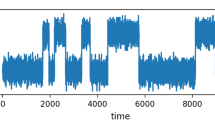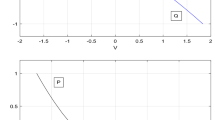Abstract
We consider a kinetic Ising model which represents a generic agent-based model for various types of socio-economic systems. We study the case of a finite (and not necessarily large) number of agents N as well as the asymptotic case when the number of agents tends to infinity. The main ingredient are individual decision thresholds which are either fixed over time (corresponding to quenched disorder in the Ising model, leading to nonlinear deterministic dynamics which are generically non-ergodic) or which may change randomly over time (corresponding to annealed disorder, leading to ergodic dynamics). We address the question how increasing the strength of annealed disorder relative to quenched disorder drives the system from non-ergodic behavior to ergodicity. Mathematically rigorous analysis provides an explicit and detailed picture for arbitrary realizations of the quenched initial thresholds, revealing an intriguing “jumpy” transition from non-ergodicity with many absorbing sets to ergodicity. For large N we find a critical strength of annealed randomness, above which the system becomes asymptotically ergodic. Our theoretical results suggests how to drive a system from an undesired socio-economic equilibrium (e.g. high level of corruption) to a desirable one (low level of corruption).
Similar content being viewed by others
References
Durlauf, S.: Nonergodic economic growth. Rev. Econ. Stud. 60, 349–366 (1993)
Brock, W.A., Durlauf, S.: Discrete choice with social interactions. Rev. Econ. Stud. 68, 235–260 (2001)
Brock, W.A., Durlauf, S.: Interactions based models. In: Heckman, J., Learmer, E. (eds.) Handbook of Econometrics: vol. V. North Holland, Amsterdam (2001)
Föllmer, H.: Random economies with many interacting agents. J. Math. Econ. 1, 51–62 (1974)
Nadal, J.-P., Phan, D., Gordon, M.B.: Multiple equilibria in a monopoly market with heterogeneous agents and externalities. Quant. Finance 5, 557–568 (2005)
Kaizoji, T.: Speculative bubbles and crashes in stock markets: An interacting-agent model of speculative activity. Physica A 287, 493–506 (2000)
Levy, M.: Social phase transitions. J. Econ. Behav. Organ. 57, 71–87 (2005)
Lux, T.: Herd behavior, bubbles and crashes. Econ. J. 105, 881–896 (1995)
Glaeser, E., Scheinkman, J.A.: Measuring social interactions. In: Durlauf, S., Young, P. (eds.) Social Dynamics. MIT Press, Cambridge (2001)
Glaeser, E., Sacerdote, B., Scheinkman, J.A.: Crime and social interactions. Q. J. Econ. CXI, 507–548 (1996)
Schneider, T., Pytte, E.: Random-field instability of the ferromagnetic state. Phys. Rev. B 15, 1519–1522 (1977)
Weisbuch, G., Salomon, S., Stauffer, D.: Social percolators and self organized criticality. In: Kirman, A., Zimmermann, J.-B. (eds.) Economics with Heterogeneous Agents. Springer, Berlin (2001)
Gordon, M.B., Nadal, J.-P., Phan, D., Vannimenus, J.: Seller’s dilemma due to social interactions between customers. Phys. A Stat. Mech. Appl. 356, 628–640 (2005)
Yin, C.-C.: Equilibria of collective action in different distributions of protest thresholds. Public Choice 97, 535–567 (1998)
Galam, S.: Rational group decision making. Physica (Amsterdam) 238A, 66 (1997)
Michard, Q., Bouchaud, J.-P.: Theory of collective opinion shifts: from smooth trends to abrupt swings. Eur. Phys. J. B 47, 151 (2005)
Krzakala, F., Ricci-Tersenghi, F., Zdeborová, L.: Elusive spin-glass phase in the random field Ising model. Phys. Rev. Lett. 104, 207208 (2010)
Author information
Authors and Affiliations
Corresponding author
Additional information
This research was supported by the São Paulo Research Foundation (FAPESP).
Rights and permissions
About this article
Cite this article
Pigeard de Almeida Prado, F., Schütz, G.M. Loss of Ergodicity in the Transition from Annealed to Quenched Disorder in a Finite Kinetic Ising Model. J Stat Phys 142, 984–999 (2011). https://doi.org/10.1007/s10955-011-0143-9
Received:
Accepted:
Published:
Issue Date:
DOI: https://doi.org/10.1007/s10955-011-0143-9




